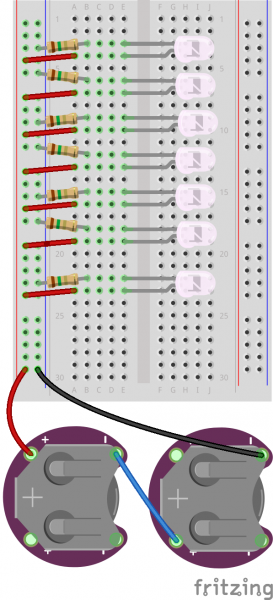LED Crystal Goddess Crown
Understanding Your Circuit
The LED Crystal Goddess Crown project is an example of a basic circuit – an electrical loop that travels from a power source along a path (i.e. wires, traces, or any conductive material), through one or more component(s), and then back to the power source. For our project, we’ll use LEDs (Light-Emitting Diodes). This electrical loop for the project is completed by soldering the LED's leads together. In order to light the LEDs, electricity from the power source must flow from the positive (+) side of the battery through an LED and back to the negative (–) side of the battery. This electric flow is called current.
In this circuit, the LEDs are soldered in parallel while the two coin cell batteries are attached in series. Take a look at the LEDs, current limiting resistors, and batteries in the circuit diagram below. When the LEDs are connected in parallel, all the positive leads will be connected together. The bent leads on the right of the LEDs (anodes +) are connected to VCC or + on the power source and to each other. Additionally, the negative leads will share a common connection. Notice that the leads on the left of the LEDs (cathodes -) are connected to ground on the power source via a resistor. We suggest using a low value resistors (i.e. a 1.5Ω with brown green gold color bands) as the current limiting resistor in this project to maximize the brightness of the LEDs.
It's important to keep in mind that certain electronic components (like LEDs) have polarity - meaning electric current can only flow through them in one direction. If hooked up incorrectly, the LEDs will not light up. The battery is also polarized; it has a positive and negative side. Always check the to make sure that all your parts are correctly oriented before soldering together a circuit.
